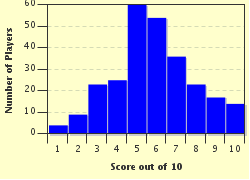Quiz Answer Key and Fun Facts
1. Sophie has felt for weeks like her face wants to explode; she has high pressure in her forehead and cheeks, a decreased sense of smell, congestion, and pain in her upper teeth. Which of these conditions is she suffering from?
2. This type of hemorrhage is particularly dangerous due to the occurrence of a lucid interval after impact, where sufferers may feel fine and thus not seek medical attention. After this, unconsciousness usually returns swiftly and death often follows. Which type of hemorrhage is this?
3. Sufferers of this disorder experience intense pain across the face originating from this nerve, which is the fifth cranial nerve. The symptoms are mainly periodic attacks of sensations such as burning, stabbing, or pressure. The condition is named for the nerve it affects, "______ neuralgia"; which of these cranial nerves is it?
4. Repeated concussions can lead to a condition called dementia pugilistica in long-term athletes, particularly boxers, from whom it derives its name.
5. Aphthous stomatitis is a benign condition that affects the mouth and can interfere with eating. It is often idiopathic (of no known cause), but often co-occurs with inflammatory systemic diseases such as systemic lupus erythematosus, inflammatory bowel disease, and Behçet's disease. What is it more commonly known as?
6. Which of these usually arises as a result of untreated otitis media, inflammation of the middle ear? It is difficult to treat and can lead to many severe complications, such as hearing loss, facial nerve palsy, and even meningitis.
7. John is experiencing many symptoms. First he has visual disturbances such as zig-zag lines through his field of vision, accompanied by feelings of numbness or pins-and-needles. This is followed by sensitivities to light, sounds, and smells, severe headache on one side, and nausea and vomiting. Afterwards, he finds he cannot think straight and feels physically exhausted. What is John most likely experiencing?
8. Viral meningitis is usually extremely severe and nearly always fatal if left untreated.
9. Which facial muscles are mainly affected by temporomandibular joint disorder (TMJD), which is dysfunction of the lower jaw joint, causing pain, difficulty in eating, and popping of the joint?
10. Blepharitis is an inflammatory condition affecting which part of the head? It can cause ulcers and chalazia that can become painful.
Source: Author
reeshy
This quiz was reviewed by FunTrivia editor
rossian before going online.
Any errors found in FunTrivia content are routinely corrected through our feedback system.


